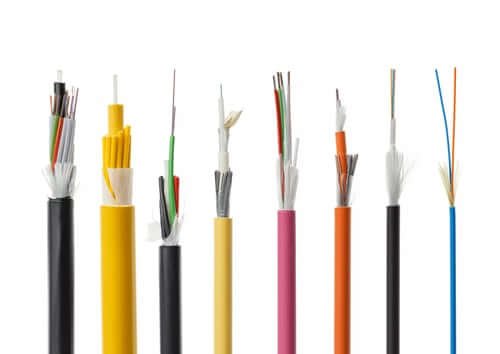How Do You Choose the Right Indoor Fiber Optic Cable?

In today’s fast-paced digital world, selecting the wrong indoor fiber optic cable can spell disaster for your network's efficiency and safety. Avoiding infrastructure mishaps and ensuring seamless connectivity is crucial. So, how do you ensure you make the right choice?
Selecting the right indoor fiber optic cable involves assessing key factors such as environment, fiber type, cable construction, fire rating, connectors, and network speed. By understanding these elements, you can ensure optimal performance and compliance with safety standards.
Choosing the right fiber optic cable can feel overwhelming, but it doesn't have to be. Imagine constructing a skyscraper; it requires precise planning and execution. Similarly, selecting fiber optic cables demands thoughtful consideration of various factors to ensure robust and reliable network infrastructure.
What Are the Environmental and Application Considerations?
The environment in which the cable will be used is a primary consideration. Indoor fiber optic cables are specifically designed for indoor environments, ensuring compliance with local fire codes1 and safety standards. Understanding the environment helps in selecting the appropriate cable type, whether strictly indoor or a dual-purpose indoor/outdoor cable.
Indoor fiber optic cables are designed to meet indoor fire codes, while indoor/outdoor cables offer versatility with flame retardancy and durability for both environments.
Indoor Cables
Indoor cables are crafted for use within buildings, providing reliable connectivity while adhering to stringent fire safety regulations2. These cables are essential for environments where fire risks are a concern, ensuring safety and performance.
Personal Story: Ensuring Safety in a Corporate Office
During a network upgrade in a corporate office, ensuring compliance with fire safety regulations was paramount. We opted for LSZH (Low Smoke Zero Halogen) rated indoor cables to minimize toxic smoke in case of a fire. This choice not only met safety standards but also provided peace of mind to the facility managers, knowing that the network infrastructure was both reliable and safe.
Indoor/Outdoor Cables
Indoor/Outdoor cables3 offer flexibility for applications that require both indoor and outdoor use. They are built to withstand varying conditions, providing flame retardancy and durability. These cables are ideal for scenarios where cables must transition between indoor and outdoor environments.
Example Use Case: Campus Network Expansion
In expanding a university campus network, we required cables that could traverse both indoor corridors and outdoor pathways. Indoor/outdoor cables with armored construction provided the necessary protection against environmental hazards while maintaining compliance with indoor safety standards. This versatility streamlined the installation process and reduced the need for multiple cable types.
Why Is Fiber Type Important?
When choosing fiber optic cables, deciding between singlemode and multimode fibers is crucial, as each serves different applications. The choice impacts distance capabilities, data transmission speed, and overall network efficiency.
Multimode fibers are suitable for short distances and high bandwidth, while singlemode fibers cater to longer distances and higher speeds.
Multimode Fiber (MMF)
Multimode fibers are designed for shorter distances, typically less than 300 meters, and are ideal for high bandwidth applications. Types like OM3 and OM4 are prevalent in data centers and corporate networks due to their enhanced bandwidth capabilities.
Personal Story: Optimizing Bandwidth in a Data Center
In a large data center, bandwidth demands were rapidly increasing due to the expansion of cloud services. We opted for OM4 multimode fibers, which provided the necessary bandwidth to support 100G Ethernet. This choice ensured that our network could handle high data rates efficiently, future-proofing the infrastructure against escalating bandwidth needs.
Singlemode Fiber (SMF)
Singlemode fibers excel in long-distance applications, providing higher data transmission speeds. With a smaller core diameter, SMF is perfect for scenarios requiring extended reach and superior speed, making it a staple in telecommunication networks4.
Example Use Case: University Campus to Research Labs
Connecting a university campus to remote research laboratories required reliable, high-speed connections over long distances. Singlemode fibers were the optimal choice, ensuring minimal signal loss and high data integrity across the extended network. This setup facilitated seamless communication between campuses and research facilities, supporting critical academic and scientific endeavors.
What Should You Consider About Cable Construction?
The internal construction of the cable influences its application and performance. It involves a choice between distribution5 or tightpack, breakout6 or fan out, and zipcord or assembly configurations, each with unique advantages and limitations.
Cable construction types vary in size, durability, and cost, offering solutions from enclosure-to-enclosure installations to device-to-device applications.
Distribution or TightPack
This construction features all buffered fibers under a single jacket, ideal for enclosure-to-enclosure installations. It's smaller, lighter, and more cost-effective but requires careful handling due to fragile terminations.
Personal Story: Simplifying Enclosure Installations
In a network hub installation, we used tightpack cables to manage the high density of fiber connections between server racks. The compact design allowed for efficient space utilization, reducing clutter and simplifying maintenance. This choice enhanced the overall organization and accessibility of the network infrastructure.
Breakout or Fan Out

Each buffered fiber in a breakout cable has its own jacket, providing durability for device-to-device applications. While more robust, these cables are larger, heavier, and come at a higher cost.
Example Use Case: Office Building Network
In an office building with multiple floors and numerous network devices, breakout cables provided the necessary durability and flexibility. The individual jackets protected each fiber, ensuring reliable connections between workstations and network switches. Although more expensive, the robustness of breakout cables minimized the risk of connectivity issues, enhancing overall network stability.
Zipcord or Assembly

Zipcord cables incorporate two or more fibers within a single jacket, suitable for patch cords and short connections. They offer simplicity and ease of use for quick installations and modifications.
Personal Story: Rapid Deployments with Zipcords
During a rapid deployment project for a retail chain, zipcord cables facilitated quick and efficient installations. The ease of handling and connecting zipcords reduced installation time, allowing us to meet tight deadlines. This flexibility was crucial in deploying temporary networks for seasonal events, ensuring seamless connectivity without extensive setup times.
How Does Cable Jacket and Fire Rating Affect Selection?
The cable jacket is central to safety and compliance, needing to meet local fire codes and possess specific properties like flexibility and tensile strength. Fire ratings7 ensure the cable's suitability for various installation environments.
Cables must adhere to NEC standards for fire safety, with appropriate ratings for riser or plenum spaces, and jacket materials should consider LSZH properties for indoor safety.
Fire Rating
In the US, compliance with Article 77 of the NEC8 is mandatory, demanding suitable ratings for cables in riser or plenum spaces. Selecting the correct fire rating ensures adherence to safety protocols.
Personal Story: Avoiding Fire Hazards in a Hospital
In a hospital network installation, fire safety was non-negotiable. We selected plenum-rated cables (OFNP) to comply with stringent fire codes, ensuring that in the event of a fire, the cables would not emit toxic fumes. This adherence to safety standards was crucial in maintaining a safe environment for patients and staff.
Jacket Material
Jacket materials9 should offer flexibility and strength while considering safety properties like Low Smoke Zero Halogen (LSZH). LSZH materials enhance safety by reducing toxic smoke emissions in case of fire.

Example Use Case: Educational Institution
At an educational institution, we prioritized LSZH-rated indoor cables to ensure a safe learning environment. The LSZH jackets minimized smoke production during potential fire incidents, aligning with the institution’s commitment to student and staff safety. This choice also facilitated easier compliance with local safety regulations.
What Role Do Connectors and Termination Play?
Choosing the right connectors and understanding the termination process is vital for maintaining network integrity. Compatibility with equipment and fiber type is essential for seamless connectivity.
Common connectors like LC, SC, and ST must match equipment specifications, and a reliable termination process ensures long-term network performance.
Connectors
Ensure connector10 compatibility with your equipment and chosen fiber type. The right connector type, such as LC, SC, or ST, facilitates efficient and secure connections.
Personal Story: Enhancing Connectivity with LC Connectors
In a high-density data center, LC connectors were chosen for their small form factor and high-density capabilities. This selection allowed us to maximize the number of connections within limited rack space, enhancing both connectivity and performance. The ease of use and reliability of LC connectors contributed to a more efficient and organized network setup.
Termination
A reliable termination process11 is crucial, enhancing fiber strength and network reliability. Some cables feature coatings that improve termination durability, supporting consistent performance.
Example Use Case: Ensuring Reliability in a Financial Firm
In a financial firm’s network upgrade, precise termination was essential to prevent data loss and ensure uninterrupted connectivity. We utilized pre-terminated cables with factory-installed connectors, reducing the risk of termination errors and enhancing overall network reliability. This meticulous approach minimized downtime and maintained the integrity of critical financial data transmissions.
Why Are Network Speed and Distance Crucial?
Evaluating required network speed and distance is a fundamental step in selecting the appropriate fiber type. It influences whether multimode or singlemode fibers are necessary.
Multimode fibers support high-bandwidth, short-distance applications, while singlemode fibers are ideal for high-speed, long-distance requirements.
Distance
For distances under 300 meters, multimode fiber suffices. However, longer distances necessitate singlemode fiber to maintain speed and reliability.
Personal Story: Long-Distance Connectivity in a University
Connecting a university’s main campus to a distant research facility required reliable long-distance connectivity. We selected singlemode fibers to ensure high-speed data transmission over the extended distance, maintaining network performance and supporting advanced research applications without signal degradation.
Network Speed
The required bandwidth12 dictates fiber choice. High-bandwidth applications benefit from OM3 or OM4 multimode fibers, whereas singlemode fibers are essential for higher speeds over extended distances.
Example Use Case: High-Speed Trading Platform
In setting up a high-speed trading platform, network speed was paramount. We opted for OM4 multimode fibers to support the high data rates necessary for real-time trading. This choice ensured minimal latency and maximum throughput, critical factors in maintaining the competitiveness and reliability of the trading operations.
Conclusion
Selecting the right indoor fiber optic cable is a multifaceted decision, involving considerations of environment, fiber type, cable construction, fire rating, connectors, and network speed. By understanding these factors, telecommunications professionals can ensure robust network performance, safety, and compliance with industry standards. This comprehensive approach not only enhances connectivity but also safeguards against potential hazards, cementing the foundation for a future-proof network infrastructure.
Footnotes
Understanding fire codes relevant to indoor fiber optic cables is crucial in ensuring safety and compliance. It involves knowing which materials and installation practices are permissible under local regulations. ↩
Fire safety regulations provide the necessary guidelines for safe indoor fiber optic cable usage, especially in environments with stringent safety demands. ↩
Indoor/Outdoor cables combine the features of both indoor and outdoor cables, offering flexibility and durability across diverse environments. ↩
Telecommunication networks rely on fiber optics for efficient and high-speed data transmission across vast distances, ensuring seamless global communication. ↩
Distribution construction involves bundling multiple fibers under a single jacket, optimizing for enclosure-to-enclosure installations. ↩
Breakout construction separates each fiber into its own protective jacket, enhancing durability for device-to-device applications. ↩
Fire ratings ensure that fiber optic cables meet safety standards for their intended environments, preventing the spread of fire and reducing toxic smoke emissions. ↩
Article 77 of the NEC outlines the requirements for fire-resistant cables in vertical runs within buildings, ensuring compliance with safety regulations. ↩
Jacket materials like LSZH enhance safety by minimizing toxic emissions during fires, while also providing necessary protection and flexibility for cable installations. ↩
Fiber optic connectors such as LC, SC, and ST are essential for creating secure and efficient connections between network devices, ensuring reliable data transmission. ↩
A termination process involves securely attaching connectors to the ends of fiber optic cables, ensuring optimal signal integrity and network performance. ↩
Fiber bandwidth refers to the capacity of fiber optic cables to carry data, directly influencing the speed and efficiency of data transmission within a network. ↩








